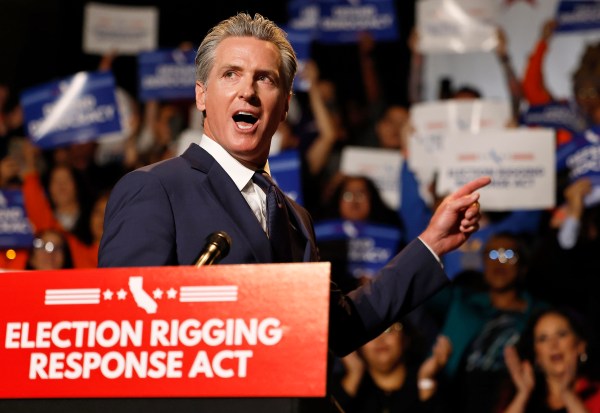Polemics are not exclusive to any side of politics. But if anything characterizes a fair cross-section of the American New Right today, it is the seething anger that permeates its rhetoric.
It is not just the left whom the New Right targets. At times, its anger seems more directed at those conservatives and classical liberals who are not on board with key parts of the New Right’s agenda.
Those who insist, for example, that free market principles remain the best economic way forward for America, or who question the wisdom of using the full might of the administrative state—bequeathed by progressives—to achieve conservative goals are viewed by many New Right figures with mild disdain at best, or even as somewhat un-American. Expressions like “neoliberal,” “libertarian ideologue,” “anti-worker,” and “market fundamentalist” litter the New Right’s lingo.
The problem with polemics is that they undermine reasoned reflection about complicated questions. Sometimes that is the point of such rhetoric. On other occasions, the point is to stir up fury and muffle perfectly reasonable critiques of the ends pursued by the New Right or the means by which they propose to realize them. The cost this has on developing sound policy, corroding limits on state power, marginalizing the moral norms upon which constitutionalism relies, and bolstering demagogues is high.
All these thoughts came to mind as I read Michael Lind’s new book Hell to Pay: How the Suppression of Wages is Destroying America. Though the book is ultimately concerned with policy, its tone reflects the broader New Right discourse: It is highly polemical with a class-war edge.
Lind’s core thesis is that American business—aided and abetted by Republican and Democratic political leaders, as well as assorted “neoliberal” economists—have effectively pulverized America’s working class by suppressing their wages. The means by which they have done so, he argues, include demolishing private-sector unions; enacting right-to-work laws; establishing operations outside America to take advantage of lower labor costs; importing low-wage migrants into America; using salary bands to restrict collective bargaining agreements; deploying non-compete clauses to prevent employees from taking their intellectual capital elsewhere; and forcing workers to sign arbitration agreements which prevent them from suing their bosses.
These and other factors have for decades hindered wage growth for the Americans who most need it, Lind argues. Their intellectual justification, he maintains, has been developed and “treated as an orthodoxy by most libertarian ideologues and free market conservatives, as well as many center-left neoliberals.” Key to this claim is what Lind calls the “human capital story” adopted by “the bipartisan American economic elite: that wages are determined automatically and without human interference by the worker’s contribution to the output of the firm or agency.”
With some exceptions, Lind regards the human capital story as a false explanation of what has happened to wages in America. The real story, he maintains, is the destruction of worker bargaining power by business leaders, with help from political and intellectual boosters. The decline of union membership is, for Lind, a key indicator of neoliberals’ success in minimizing blue-collar America’s capacity to resist wage suppression.
At this point, however, significant cracks begin to appear in Lind’s argument. First, private sector union membership has been declining throughout the Western world for a long time. Lind acknowledges this fact but argues that private union membership remains higher in other developed nations. Yet all that means is that some countries’ laws incentivizing private sector union membership have only yielded a slower rate of decline than in America.
This suggests that growing numbers of workers have actively chosen not to join unions. Some are no doubt hostile, as Lind notes, to the uncritical embrace of sundry progressive causes by today’s union leaders (many of whom, in dynastic fashion, are the children of union officials) to which blue-collar and millions of other Americans are hostile. It is also likely that many workers see little economic benefit to joining unions. They are also surely aware of how union officials’ refusal to contemplate the effects of technological change, their disinclination to face the implications of foreign competition, and their blind devotion to a Democratic Party led by white liberal progressives increasingly inclined to loath their own country, contributed to the self-destruction of once-great metropoles like Detroit.
Alongside this weakness in Lind’s cause-and-effect logic looms another problem: the considerable evidence indicating that wages in America have neither been static nor slow to increase. Serious economic thinkers and commentators—figures like Scott Winship, Veronique de Rugy, Donald Boudreaux, Michael Strain, Scott Lincicome, Phil Gramm, Robert Ekelund, and John Early (none of whom, I can assure readers, are “sycophants,” to use Lind’s expression, for corporate America)—have presented a different, much more complicated story than Lind’s.
Put simply, that story involves real growth in income and wages across America’s income distribution. Certainly, it is a story of ups-and-downs (recessions matter) as well as changes in which types of blue-collar and medium-income jobs earn more than others. But the key point is that there’s been overall and significant wage growth for the groups Lind claims have had their wages suppressed.
What, then, is Lind’s solution to the problem he believes is driving much of America’s social and cultural dysfunctions? Unlike some New Right figures, Lind doesn’t obfuscate when explaining what he believes is necessary. Part of his proposal to “Restore Worker Power in America” involves major changes to particular immigration and trade policies. Lind’s ambitions, however, go beyond tinkering: They are of macro-economic and macro-political proportions.
Part of Lind’s solution is “a new American System in the tradition of Hamilton, Clay, Lincoln, Franklin D. Roosevelt, and Eisenhower” revamped for an information age. What’s left out is the evidence, assembled by economic historians like Phillip W. Magness and Amity Shlaes, detailing how damaging the American System endeavors advanced by Henry Clay and FDR respectively were to America’s economy and its commitment to constitutionally limited government. Similarly, back in the 19th century, Harvard economist F.W. Taussig showed in his Tariff History of the United States how America’s protectionist turn after the Civil War led to massive cronyism and collusion between legislators and politically connected businesses at everyone else’s expense.
Overhanging all this, however, is an even grander scheme for driving what Lind calls “national developmentalism.” Lind specifies that “[o]rganized labor, in new and effective forms, should take part in a new tripartite government-industry-labor partnership for production and shared prosperity.” This forms the political foundation of Lind’s economic vision. It also has a name that he does not use: corporatism.
Corporatism has many versions, and has historically attracted supporters from the left and right. While it doesn’t seek to abolish private property and markets, it does insist on thoroughly embedding their workings in a series of institutionalized coordinations between unions and business overseen by the state from the top-down.
Hard forms of corporatism manifested themselves in regimes like Mussolini’s Italy (invoked by FDR and various New Dealers as an economic model worthy of close study), Franco’s Spain, and Vichy France. The corporatism that most parallels Lind’s tripartite partnership is of the soft variety applied by Christian Democrat and Social Democrat governments in Western Europe after World War II. This included mandated collective bargaining; worker co-determination arrangements; the establishment of work councils (dominated by union officials) inside businesses that employers were required to consult; and creating semi-official chambers of labor and employers which were given a formal role in drafting legislation.
The ultimate goal of these and similar measures is greater economic and job security, as well as less economic upheaval and less inequality: the same objectives that Lind’s national developmentalism seeks to realize.
The problem is that, over time, these policies generate systematic economic and political dysfunctions that are hard to dislodge. They provide, for instance, established businesses with legal mechanisms to promote their interests over taxpayers, consumers, start-ups, and entrepreneurs who aren’t hard-wired into these structures. The same structures enable unions to promote their members’ well-being over and against those who prefer not to join unions (not to mention the unemployed). Likewise, a business’s success depends less on innovation in these conditions and much more upon its political clout.
Not only is this unfair. Over time, it adds up to an increasingly un-competitive economy, rampant cronyism, sclerotic labor markets, declining innovation, and growing tendencies to look to the state and technocrats to resolve problems from the top-down. In his book Mass Flourishing, for example, the Nobel Prize-winning economist Edmund Phelps details at length the clear linkages between the prevalence of corporatist mindsets and structures and weakening overall economic performance in many European countries.
These are the types of long-term, empirically verifiable, and entirely predictable problems associated with most economic proposals emanating from New Right thinkers, whose response to criticism, alas, is more-often-than-not polemics, ad hominem attacks, or the recycling of long-discredited economic theories.
The sad irony is that neither the polemics nor the New Right or Lind’s interventionist proclivities will provide long-term economic security for workers or promote the dynamic growth and productivity that ultimately drives higher living standards and real wage increases across the income-strata. No amount of righteous indignation or reinventing the corporatist wheel can change those facts. By persisting in such denialism, the New Right turns out to be more like the Old Left than it cares to admit.






Please note that we at The Dispatch hold ourselves, our work, and our commenters to a higher standard than other places on the internet. We welcome comments that foster genuine debate or discussion—including comments critical of us or our work—but responses that include ad hominem attacks on fellow Dispatch members or are intended to stoke fear and anger may be moderated.
With your membership, you only have the ability to comment on The Morning Dispatch articles. Consider upgrading to join the conversation everywhere.